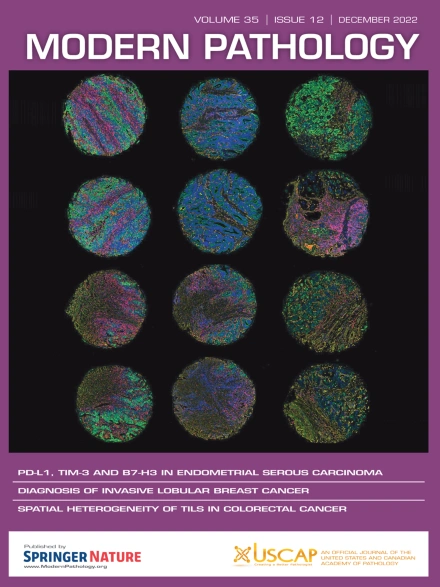在筛选的II期结肠癌人群中,肿瘤-间质比率的预后价值:肿瘤内部位特异性评估和肿瘤萌芽协同作用。
IF 7.1
1区 医学
Q1 PATHOLOGY
引用次数: 0
摘要
肿瘤间质比(TSR)在包括结肠癌在内的多种癌症中显示出预后价值。这项回顾性、多中心队列研究旨在探讨TSR在筛选的II期结肠癌人群中的预后价值,无论是单独的还是联合肿瘤出芽的。该队列包括497例II期结肠癌手术切除患者。根据van Pelt等人提出的程序确定TSR,根据国际肿瘤出芽共识会议(ITBCC)的指南评估肿瘤出芽。我们的研究结果表明,与基质比例低(≤50%基质面积)的肿瘤患者相比,基质比例高(≤50%基质面积)的肿瘤患者的5年复发时间(TTR) (HR = 1.95, p = 0.05)、无复发生存期(RFS) (HR = 1.63, p = 0.02)和总生存期(OS) (HR = 1.05, p = 0.07)更短。预后影响仅局限于肿瘤最深处浸润前部的TSR测定,随着检查范围的扩大而失去意义。TSR联合肿瘤出芽进一步改善了预后分层。高基质含量和高出芽的肿瘤与低基质和低出芽的肿瘤相比,具有更大的侵袭性风险和更差的5年生存结果(TTR;HR 4.47 p < 0.01, RFS;HR 2.71 p < 0.01, OS;HR 2.20 p = 0.01)。该研究强调了TSR评估标准化程序的重要性,并建议同时评估TSR和肿瘤萌芽可以提高预后的准确性,并有助于临床决策。本文章由计算机程序翻译,如有差异,请以英文原文为准。
Prognostic Value of Tumor-Stroma Ratio in a Screened Stage II Colon Cancer Population: Intratumoral Site-Specific Assessment and Tumor Budding Synergy
The tumor-stroma ratio (TSR) has shown a prognostic value in various cancers, including colon cancer. This retrospective, multicenter cohort study aimed to investigate the prognostic value of TSR in a screened stage II colon cancer population, both independently and in combination with tumor budding. The cohort included 497 patients who underwent surgical resection for stage II colon cancer. TSR was determined based on the procedures proposed by van Pelt et al, and tumor budding was evaluated according to the guidelines from the International Tumor Budding Consensus Conference. Our findings demonstrate that patients with tumors categorized as having a high proportion of stroma (>50% stroma area) had a shorter 5-year time to recurrence (hazard ratio [HR], 1.95; P = .05), recurrence-free survival (HR, 1.63; P = .02), and overall survival (HR, 1.05; P = .07) compared with those with tumors categorized as having a low proportion of stroma (≤50% stroma area). The prognostic effect was specific to TSR determination at the deepest invasive front of tumor and lost significance as the examination area expanded. Combining TSR and tumor budding further improved prognostic stratification. Tumors with high stromal content and high-grade budding exhibited a significantly more aggressive risk profile and poorer 5-year survival outcomes compared with those with stroma-low and budding-low tumors (time to recurrence: HR, 4.47; P < .01; recurrence-free survival: HR, 2.71; P < .01; and overall survival: HR, 2.20; P = .01). The study highlights the importance of standardized procedures for TSR assessment and suggests that evaluating both TSR and tumor budding could improve prognostic accuracy and aid in clinical decision-making.
求助全文
通过发布文献求助,成功后即可免费获取论文全文。
去求助
来源期刊

Modern Pathology
医学-病理学
CiteScore
14.30
自引率
2.70%
发文量
174
审稿时长
18 days
期刊介绍:
Modern Pathology, an international journal under the ownership of The United States & Canadian Academy of Pathology (USCAP), serves as an authoritative platform for publishing top-tier clinical and translational research studies in pathology.
Original manuscripts are the primary focus of Modern Pathology, complemented by impactful editorials, reviews, and practice guidelines covering all facets of precision diagnostics in human pathology. The journal's scope includes advancements in molecular diagnostics and genomic classifications of diseases, breakthroughs in immune-oncology, computational science, applied bioinformatics, and digital pathology.
 求助内容:
求助内容: 应助结果提醒方式:
应助结果提醒方式:


